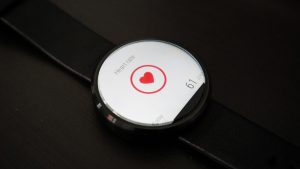The coronavirus disease 2019 (COVID-19) was declared a pandemic by the World Health Organization on the 11th of March 2020. This situation reminds us of the Severe Acute Respiratory Syndrome (SARS) outbreak in 2002-2003, as both outbreaks have a similar origin and both diseases are caused by very similar viruses: SARS coronavirus (SARS-COV), and SARS-COV-2. Nevertheless, the SARS outbreak was fully contained while COVID-19 has been spreading worldwide, with terrible effects on both global health and economy. This unpredictable and overwhelming situation has led to the launching of many new research projects, and many others have been reoriented to help with the current global crisis. This is the case of WECARMON (wearable cardiorespiratory monitor), a project funded by the European Union’s program H2020 aimed to monitor chronic respiratory patients by using a wearable armband. However, what is the role of a wearable device in the COVID-19 crisis?
Early isolation of individuals with an infectious disease has been demonstrated to be a very effective strategy to control epidemics. In fact, isolation of patients is considered to be one of the main reasons why the SARS outbreak was fully contained in 2002-2003. Unfortunately, in contrast to SARS, the infectious period of COVID-19 often begins before the patient shows the first symptoms [1], making it harder (or even impossible) to identify those individuals who need to be isolated. Furthermore, the number of SARS-COV-2-infection tests is too limited to establish a massive testing strategy. What if physiological information recorded by wearable devices allowed early detection of SARS-COV-2 infection? In that case, given the wide availability of wearable devices, these could be used as a basis for a massive screening tool that could help us to early identify potentially infected individuals.
Many wearable devices record biomedical signals that can be used to obtain information about the autonomic nervous system (ANS), such as electrocardiogram (ECG) and/or pulse photoplethysmogram (PPG, the technology on which the so-called optical heart rate sensors are based). The ANS is a part of the nervous system that acts in an unconscious manner. It is composed of two branches: the sympathetic branch, which activates the body in case of alarm (“fight or flight”); and the parasympathetic branch, which relaxes the body (“rest and digest”). The overall status of the body depends on which branch is dominating and how strong this dominance is. Technically, this status is known as the sympatho-vagal balance. The potential relevance of the ANS information in application to the COVID-19 crisis is that some ANS markers have been reported to be sensitive to early stages of other respiratory dysfunctions and/or infections. Of course, an individual’s body can be activated or relaxed because of many reasons. Therefore, when applied to the general population, the ANS information is usually not very specific (the performance in detecting ONLY objective events is not very good). Nevertheless, it is usually very sensitive (the performance in not missing objective events is very good), so such information may still be useful for a massive screening tool that identifies potentially SARS-COV-2-infected individuals early, who could be isolated before showing new symptoms or even be tested by a more specific system.
Autonomic nervous system and wearable devices
Among many other things, the ANS regulates the heartbeat. This means that, somehow, we can indirectly assess ANS information by observing the occurrence of heartbeats. Just as an example, it is easy to infer that the sympatho-vagal balance of a person is more elevated (they are more activated) when the heart rate is 150 beats per minute than when it is 60 beats per minute. The ANS information in beat occurrence, however, is not limited to the mean heart rate. In fact, there is much more of the ANS information in small beat-to-beat variations in heart rate, which are referred as “heart rate variability” (HRV). The quantification of these variations represents a powerful approach for non-invasive assessment of the ANS, which has led to several biomarkers [2]. Furthermore, different markers are affected in different manners by the sympathetic and/or parasympathetic branches, and that is why they offer much more information than the simple observation of the mean heart rate. In case of PPG signal, it can sense the heartbeats through arterial pulses. Although it is not exactly the same, the so-called “pulse rate variability” (PRV) is well known to be highly correlated with the heart rate variability.

Figure 1. A prototype for a wearable device to record ANS information.
The ANS controls also respiration. Specifically, it regulates the frequency of filling/emptying of the lungs known as respiratory rate (RR) and the amount of air that is displaced in such process. Thus, similarly to the case of heart beating, we can assess the ANS from respiratory parameters. Fortunately, we can obtain respiratory information from biomedical signals that can be recorded by wearable devices, such as ECG and PPG [3]. Respiration changes the ECG morphology by changing the conditions in which the electricity is conducted from the heart to the surface of the body due to the filling and emptying of the lungs [4]. In addition, there is a phenomenon known as respiratory sinus arrhythmia that consists of respiration-synchronous variations in heart rate. That is, heart rate variability is (not exclusively) related to respiration. In fact, the quantification of those cardiorespiratory interactions also offers other useful ANS information in addition to RR. The case of PPG is similar to the ECG case. Respiratory sinus arrhythmia can be observed in PPG, and respiration affects the PPG morphology. In this case, the morphology is affected through changes in the volume of blood pumped from the left ventricle (stroke volume), and through changes in intrathoracic pressure and arterial stiffness, which lead to changes in pulse wave propagation; also allowing a RR estimation.
That is how ANS information can be obtained from wearable devices. The PPG acquisition technique consists of illuminating a tissue and measuring the amount of light that is transmitted or reflected, and one of the most-widely-used and available devices has a built-in light emitter and detector: a smartphone. Specificallly, smartphones have been used to obtain ANS information by using PPG signals acquired by their built-in flashlight and camera [5,6].
Conclusion
In summary, biomarkers extracted from biosignals acquired by wearable devices may have a role in the early identification of potential SARS-COV-2-infected individuals. If so, it could be an effective tool for containing the COVID-19 outbreak. In other words, physiological information measurable at almost every home is a potential tool to flatten the curve.
* * *
By Jesús Lázaro (@jlazarop), MSCA Individual Fellow of the WECARMON project at University of Zaragoza.
More information:
- Wilder-Smith et al. (2020).
- Heart rate variability: standards of measurement, physiological interpretation and clinical use, by members of the Task Force.
- Charlton et al. (2016).
- Lázaro et al. (2014).
- Scully et al. (2012).
- Lázaro et al. (2015).
Other resources:






